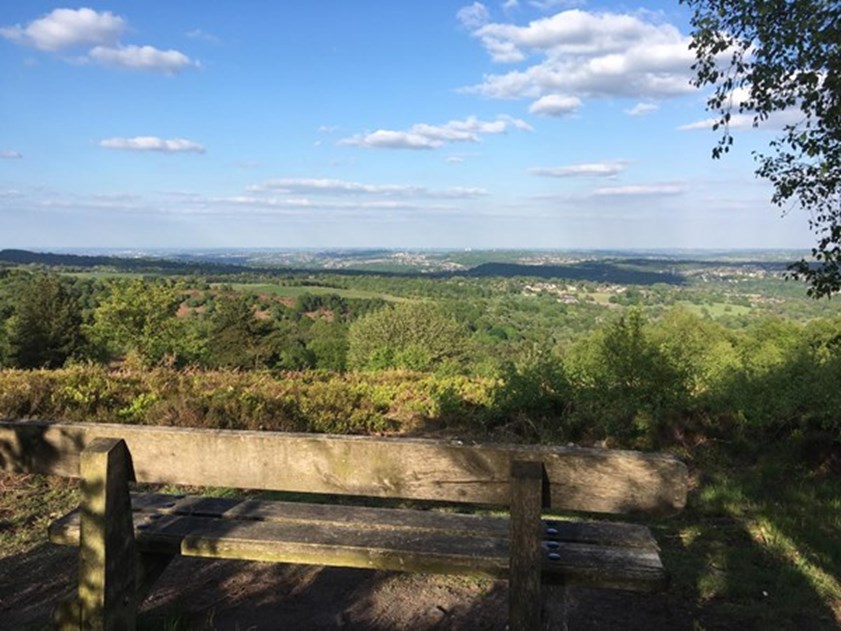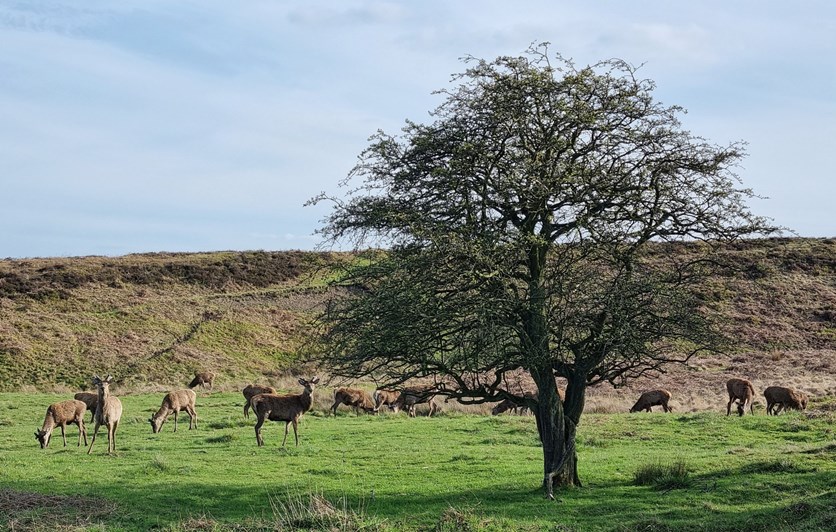Blacka Moor - deer & moorland in the city

The moorland in and around south-western Sheffield acts as a link between the city itself and the wider Peak District National Park. Much of this vast space, that lies within the city boundary, is in public or charitable ownership and as such is accessible and well-maintained.
These areas offer great walking and, in certain spots, mountain biking, all year round; whether it’s in spring, when new life returns to the area, through to late summer when much of the area gets a deep dusting of purple heather bloom, to winter, when the expansive landscape feels more exposed to the elements.
Blacka Moor, less than 20 minutes from the city centre, is a remarkable place. It's accessible from bus routes along Hathersage Road (get off just before the Fox House pub) and along Baslow Road (the terminus of the 97 bus) - as well of course by bike and foot.
Made up of both moorland and forest, Blacka Moor is the largest of the Wildlife Trust’s nature reserves, with 181 hectares of land providing home to a huge range of migrant birds including willow warblers, cuckoos and black caps. It’s also a great spot to see majestic red deer – Britain’s largest mammal, just a few miles from the hustle and bustle of the city centre.
There are a variety of habitats, trails, flora and fauna (as well as some butterflies and lizards only seen within the reserve), and plenty of hidden treasures off the smaller trails.
For a walk from the bus stop on Hathersage Road, walk back in the direction of Sheffield for about 200 metres, towards the car park next to the Strawberry Lee Plantation, and follow the below directions:
1. Follow the track down towards Totley Moor until you get to the compost bins, which contain chipped rhododendron that has been removed from the adjacent woodland to make space for native species, as well as bracken that has been cut and harvested.
2. Go through the kiss gate and follow the route across Cowsick Bog. This is probably one of the richest areas of the reserve, as it contains a great variety of plants – cross-leaved heath, cotton grass, hare's tail cotton grass, sphagnum mosses (the stuff that peat's made of), cranberry and a wonderful display of the locally rare bog asphodel.
3. Continue through the heath, which looks wonderful in July/August when the heather is in full bloom. As the cattle graze and trample here they help to create and conserve the conditions needed for ground-nesting birds and a variety of insects for birds to feed their chicks on.
4. You'll then get to the bracken plots. Bracken can completely inundate heather and bilberry, so its spread is controlled. But it does look spectacular as a splash of rust-colour in the drab winter months.
5. Off Strawberry Lee Road (track), you can just about see evidence of a stone circle just south of the track – but only in winter. Protruding from the bracken is a single standing stone. Find that and, with a bit of probing with your feet, you'll feel a circle of stone from that one, hidden amongst the dead bracken.
6. As you head left from the Lenny Hill 'crossroads' the path narrows, and down the steep, boulder-strewn bank is the rushing torrent of Blacka Dyke. You'll get to the wooded clough of the dyke, which provides welcome shelter in the winter months and shade in the summer.
7. As you come out back onto the heathland to the right, you'll see the sea of purple in late July/August. The heather is so dense here, that you'll feel immersed in honey, so intoxicating is the smell. Stonechat can usually be seen and heard here, with their distinctive whistle-chat-chat song.
8. This section of the walk is perhaps one of the best parts of heathland. The mix of open heather and bilberry and the scattered birch somehow have a magical quality – you can imagine wild boar or wolves lurking in these kinds of places, with patches of shade and open glades adding to the atmosphere (there's only have red deer here, not the latter two!). The firebreak further on hosts a wonderful mix of cowberry, crowberry, heather, bilberry and grasses.
9. It is worth exploring Strawberry Lee Plantation – this wood is very different from the other woods at Blacka Moor. It has a distinctive atmosphere, as the rhododendron protects the wood from the winds, creating a microclimate suitable for mosses and lichens to thrive and creating stillness, which is unusual in this part of the Peak District.

Not far away, the Moorland Discovery Centre set in the Longshaw Estate, is a great place for families, schools and youth groups to learn more about the environment that surrounds Sheffield. Close to Padley Gorge, the discovery centre delivers environmental education sessions but also organises regular events for the community. It also holds twice-monthly volunteer days, where people can help conserve the nature reserve by doing things like removing invasive species and improving paths.
A little further out, near Hathersage, are the Burbage Moors. The Burbage Moors are managed by Sheffield City Council and are designated a Special Area of Conservation. The area has undergone some recent work to improve access and reintroduce native species, resulting in a beautiful and varied landscape – right on Sheffield's doorstep. Meanwhile the nearby North Lees estate incorporates both literary connections (the hall is thought to have provided inspiration for Charlotte Brontë when writing Jane Eyre) and a dramatic landscape, dominated by the imposing cliffs of Stanage Edge.